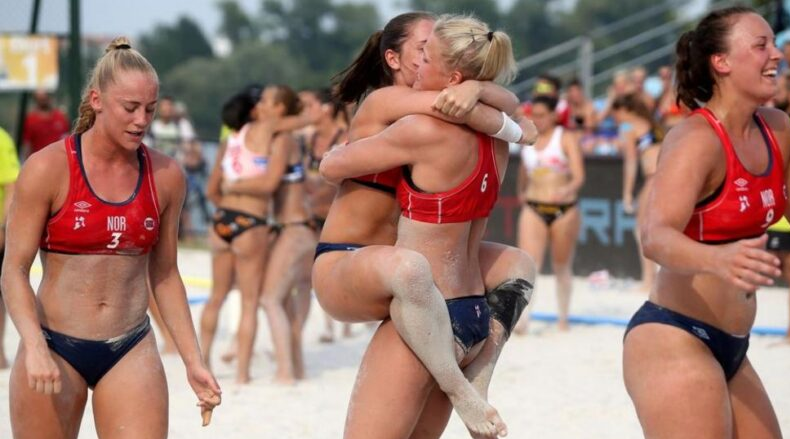
‘Bikini boycott’ by Norway team a hint to un-sexualise women in sports

If you thought the idea of asking women athletes to dress modestly or ‘cover up’ was sexist enough, think again; it can be the other way round too. Telling them to wear skimpy clothes under the pretext of international dress code can reek of deep-rooted patriarchy too.
In a latest instance, the women’s beach handball team of Norway has been fined 1,500 euros on Monday after players chucked the official dress code of bikini bottoms to wear the more comfy shorts.
The European Handball Federation has called it “a case of improper clothing” that breached the Athlete Uniform Regulations delineated in the IHF Beach Handball Rules of the game and said disciplinary action has been initiated against the team.

The team, however, has received claps from the Norwegian Handball Federation (NHF) which has cheered its women for finally breaking the sexist dress code against which they have been complaining since 2006.
“We at NHF stand behind you and support you. Together we will continue to fight to change the rules for clothing so that players can play in the clothes they are comfortable with,” the federation said in a social media post.
Women athletes, as per International Handball Federation rules, are required to wear bikini bottoms “with a close fit and cut on an upward angle toward the top of the leg”. While the sides of the bottoms for women cannot be longer than four inches, men can wear shorts four inches above the knee.
Pressure to play inconveniently feminine
The lack of parity in dress code between men and women in sporting events including the mighty Olympics has been a burning topic of debate over the past few years.
In 2011, the Badminton World Federation left female players flummoxed and invited heavy public censure, when it issued new guidelines that wanted women players to “ensure attractive presentation” at tournaments, or in short, look feminine enough. The guidelines insisted that women players “wear skirts or dresses” instead of shorts and pants.
The guideline was not only criticised as utterly sexist, but also an inconvenient proposition for players from Muslim countries, who would be required to wear a skirt above their usual long pants if they were to follow it.
“When you dictate apparel for reasons of sexuality, it should be offensive,” Donna Lopiano, a former CEO of Women’s Sports Foundation had told New York Times.
Who will define the length of your skirt?
The irony of the dress codes at these sporting events is the changing definition of femininity from association to association.
So, if the Badminton Federation wanted women players to wear skirts and dresses to exude femininity, the Ladies Professional Golf Association almost resorted to slut-shaming female golfers, even stooping down to measure the length of their skirts in its new guidelines issued in 2018.
The ‘can’t wears’ included ‘plunging necklines’ and ‘leggings’ while players were cautioned not to wear skirts, skorts and shorts which reveal the “bottom area (even if covered by under shorts) at any time, standing or bent over”. Players were told they would be fined $1,000 if they didn’t adhere to the guidelines.
As far as skin show is concerned, women wear much skin-baring clothes than men in sports such as gymnastics, track and field, volleyball and beach volleyball among others. Women gymnasts, for instance, are allowed to only wear leotards (similar to a bodysuit) while their male counterparts have the luxury to layer up with shorts or long leggings over their bodysuits.
Several sports require the women’s outfit to be skintight and not otherwise. As per the trampolining dress code set by the Federation Internationale de Gymnastiques (FIG), women should wear “a leotard or unitard with or without sleeves (must be skintight). Long tights may be worn (must be skintight and be the same colour as the leotard),” and not wear clothes which are not ‘skintight’. The men, however, can wear sleeveless or short sleeves singlet, gym trousers or gym shorts.
A fact sheet on “sexploitation” in sports released by the Australian government in 2012 criticized the stark difference between the uniforms of male and female athletes. “Women’s beach volleyball […] has introduced uniforms intentionally to focus attention on the athletes’ bodies rather than for any technological, practical, or performance-enhancing reasons. Women must compete in bra-style tops and bikini bottoms that must not exceed six centimeters in width at the hip (men compete in shorts and singlets),” the Huffington Post quoted the report as saying.
In a conversation with Bustle, FIG’s vice president Slava Corn, however, refused any gender discrepancy in dressing, adding that the requirement for the dress to be tight is for safety. “Since they move so much we cannot have a piece of material impede their movement or possibly cause an injury.”
In the recent past, several countries haven’t been able to participate in Olympic events due to the absence of ‘modest dress codes’ like scarves by women of Islamic countries. In 2010, the FIFA’s dress code didn’t allow Iranian women to compete in the Youth Olympic Games, due to a ban on headscarves. However, the same was changed in the 2016 FIFA Regulation Handbook later.
Winds of change
However, thanks to protests by players like the Norway women’s team, the sexism in dress code is getting diluted by the day. In a bid to bring inclusivity to the sport and pay respect to cultural beliefs of some participating countries, the International Volleyball Federation in 2012, announced that its female players would no longer be mandated to wear only bikinis and instead and opt for shorts and sleeved tops.
While some players still want to stick to the old ways, it wouldn’t be wrong to say that a less sexualized and more practical dress code would go a long way in helping a sportswoman achieve her desired milestone.


